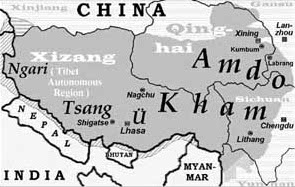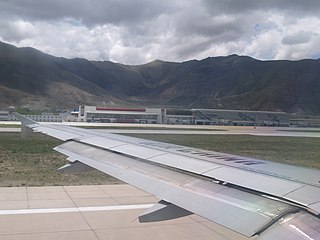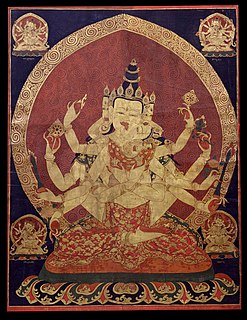
The Drukpa Lineage, or simply Drukpa, sometimes called either Dugpa or "Red Hat sect" in older sources, is a branch of the Kagyu school of Tibetan Buddhism. The Kagyu school is one of the Sarma or "New Translations" schools of Tibetan Buddhism.
Tai Situ Changchub Gyaltsen was a key figure in Tibetan History. He was the founder of the Phagmodrupa Dynasty which replaced the old Mongol-backed Sakya regime, ending the Tibet under Yuan rule. He ruled most of Tibet as desi (regent) from 1354 to 1364, and as a law-giver, politician and religious patron, he created a heritage that lasted for centuries.

The Phagmodrupa Dynasty or Pagmodru was a dynastic regime that held sway over Tibet or parts thereof from 1354 to the early 17th century. It was established by Tai Situ Changchub Gyaltsen of the Lang family at the end of the Yuan dynasty. The dynasty had a lasting importance on the history of Tibet; it created an autonomous kingdom after Mongol rule, revitalized the national culture, and brought about a new legislation that survived until the 1950s. Nevertheless, the Phagmodrupa had a turbulent history due to internal family feuding and the strong localism among noble lineages and fiefs. Its power receded after 1435 and was reduced to Ü in the 16th century due to the rise of the ministerial family of the Rinpungpa. It was defeated by the rival Tsangpa dynasty in 1613 and 1620, and was formally superseded by the Ganden Phodrang regime founded by the 5th Dalai Lama in 1642. In that year, Güshi Khan of the Khoshut formally transferred the old possessions of Sakya, Rinpung and Phagmodrupa to the "Great Fifth".

Rinpungpa was a Tibetan regime that dominated much of Western Tibet and part of Ü-Tsang between 1435 and 1565. During one period around 1500 the Rinpungpa lords came close to assemble the Tibetan lands around the Yarlung Tsangpo River under one authority, but their powers receded after 1512.

Gongma Drakpa Gyaltsen was a King of Tibet who ruled in 1385–1432. He belonged to the Phagmodrupa Dynasty, which was the leading regime in Tibet between 1354 and 1435. His reign was comparatively tranquil, but he was also the last ruler of the dynasty to wield full powers over the central parts of Tibet.
Kunga Lekpa was a King of central Tibet who ruled from 1448 to 1481. He belonged to the Phagmodrupa Dynasty, which was the leading political regime in central Tibet from 1354 to 1435, and retained a certain political status until the early 17th century. His time saw the further fragmentation of Tibetan politics.
Ngawang Tashi Drakpa was a king of Tibet who ruled in 1499–1554 and 1556/57–1564. He belonged to the Phagmodrupa Dynasty which was the dominating regime in Tibet from 1354 to 1435 and maintained a degree of authority until the early 17th century. His rule is sometimes considered to be the last of importance in the history of the dynasty.
Drowai Gonpo (1508–1548) was a king who wielded power in parts of Central Tibet from 1524 to 1548. He belonged to the Phagmodrupa dynasty which reigned over Tibet or parts of it from 1354 to the early 17th century.
Kagyud Nampar Gyalwa was a prince in Central Tibet. He belonged to the Phagmodrupa dynasty which reigned in Tibet or parts of it from 1354 to the early 17th century. He is sometimes represented as the penultimate ruler of the line, although the circumstances about his political position are ill-recorded.
Norzang (1403–1466), in full Norbu Zangpo, was the founder of the power of the Rinpungpa Dynasty in Central Tibet.
Donyo Dorje was the third and most powerful prince of the Rinpungpa Dynasty that held power in much of Central Tibet from 1479 to 1512.
Ngawang Namgyal was a prince of the Rinpungpa Dynasty that dominated Tsang in West Central Tibet between 1435 and 1565. He reigned from 1512 to 1544.
Karma Tseten, also known as Zhingshak Tseten Dorje was a king of Upper Tsang in West Central Tibet. He was the founder of the Tsangpa Dynasty, that had an important role in the history of Tibet from 1565 to 1642, ruling in the period 1565-1599.
Karma Phuntsok Namgyal was a king of Tibet who ruled from 1618 to 1620. He belonged to the Tsangpa Dynasty that held power in Tsang since 1565 and was the foremost political and military power in Tibet until 1642.
Karma Tenkyong, in full Karma Tenkyong Wangpo, was a king of Tibet who ruled from 1620 to 1642. He belonged to the Tsangpa Dynasty which had been prominent in Tsang since 1565. His reign was marked by the increasingly bitter struggle against the Gelugpa sect and its leader the Dalai Lama. The final outcome was the crushing of the Tsangpa regime and the establishment of the Dharma-based Tibetan state that endured until 1950.
Pagsam Wangpo, a key figure in the history of the Drukpa Lineage of Tibetan Buddhism, was born at Chonggye, in the Tsang province of Tibet a natural son of the prince of Chonggye, Ngawang Sonam Dragpa. He was an elder cousin of the 5th Dalai Lama, Ngawang Lobzang Gyatso (1617-1682).






